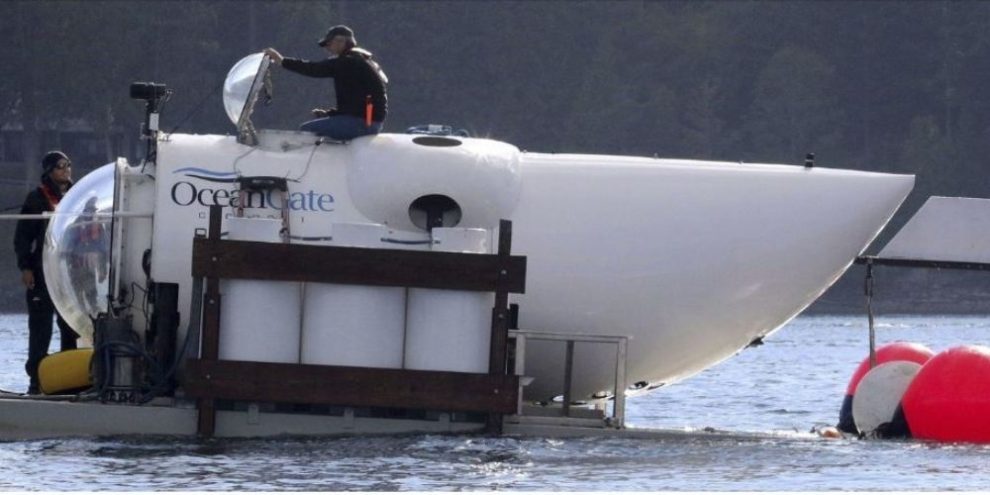
By Michael MacDonald
The search for a submersible carrying five people to the bottom of the North Atlantic took a grim turn Thursday as the U.S. Coast Guard confirmed that a “debris field” had been discovered by a remotely operated vehicle near the wreck of the Titanic.
The brief coast guard statement said experts were evaluating the find, which was spotted by a crew operating an ROV from aboard the Horizon Arctic, a Canadian-flagged offshore tug and supply vessel.
No other details were released. A media briefing was planned for 3 p.m. EDT.
The submersible Titan, operated by U.S.-based OceanGate Expeditions, lost contact with surface vessels on Sunday morning as it was nearing the shipwreck during a 3,800-metre dive that usually takes about two hours.
Since then, a massive international search effort has been assembling about 700 kilometres southeast of Newfoundland. The search reached a critical stage Thursday as the small vessel's air supply was believed to be running low, but that looming deadline assumed the submersible was still intact.
Jamie Pringle, a professor in forensic geosciences at Keele University, in the United Kingdom, said the first 24 hours are the "golden hours" for a below-surface search, and after that the chances for success decline sharply.
"That's when most people are found in water searches, and after that time chances of survival reduce massively," he said in an interview Thursday, citing low temperatures, declining oxygen and rising levels of fatigue.
"Currently, the chances are less than one per cent" for Titan's crew and passengers.
American authorities have said "banging sounds" were detected in the search area on Tuesday and Wednesday, though the cause was unclear.
Paul Johnston, curator of maritime history at the Smithsonian, in Washington, D.C., said OceanGate's brand of "frontier tourism" is a risky business. Asked about the debris field discovery, Johnston said the find raises questions about making the Titanic off limits to tourists.
"I believe that the current accident will probably diminish interest in Titanic tourism and maybe ‘risk tourism’ in general," he said in an interview Thursday. He rejected the notion that these undersea tours are a form of exploration.
"(This is) people who are going down to look at an underwater graveyard," he said. "Who cares how much iron there is in the water column around the ship, or how quickly the rusticles (on the Titanic) grow. To me, that’s of no scientific interest whatsoever .... I think it’s a plaything for wealthy people — a checkbox on a bucket list.”
As the search entered its fifth day, two remotely operated vehicles slipped into the water to search the dark ocean floor near the world's most famous shipwreck.
The United States Coast Guard, which is leading the search for the privately owned Titan, confirmed that the ROV from Horizon Arctic had reached the Titanic site early Thursday. As well, another ROV from the French vessel L'Atalante was also in the area, the coast guard said.
The state-of-the-art Victor 6000 deep sea ROV, operated by France’s state-run ocean research institute, has robotic arms that could be used to secure lifting cables to Titan if the submersible is found, said Olivier Lefort, the institute's fleet director. He said Victor’s powerful lights and cameras can be used to find things within a 25-square-metre area.
Among those aboard Titan are Stockton Rush, CEO of OceanGate, based in Washington state.
As for Titan's air supply, OceanGate officials have told the U.S. Coast Guard that it can last up to 96 hours, which suggested a limited supply by Thursday morning.
Dr. Ken LeDez, a specialist in diving and hyperbaric medicine, said that number could be misleading. "It’s not like flicking a switch," the associate professor at Memorial University in St. John’s said Thursday.
If anyone on board is still alive, there's no way to know how much oxygen they've used over the past four days, LeDez said in an interview. If someone has died, there may be more oxygen available for the others. And if they have no heat source, they may be very cold or hypothermic, which would mean they’re using less oxygen, he said.
"There may still be a prospect for some to survive,” LeDez said. “It’s too soon to say it’s over."
The search is being conducted near a renowned fishing area known as the Grand Banks. Winds in the area Thursday morning were gusting up to 30 kilometres an hour, and swells were more than a metre high, the coast guard said.
Meanwhile, an expert with the Woods Hole Oceanographic Institution, in Falmouth, Mass., said the banging sounds detected earlier this week may have been caused by ocean creatures. Recordings of the noises are being analyzed by the U.S. Navy.
On another front, other experts have come forward to raise concerns about Titan, which was never "classed" or certified by an independent third party to ensure it met certain safety standards.
William Kohnen, president and CEO of the California-based engineering firm Hydrospace Group, has said about 95 per cent of all submersibles are certified. Titan, he said, "is very much an outlier."
Kohnen was part of a group of engineers and industry professionals who wrote to Rush in 2018 to express their concern. Their letter, first obtained by the New York Times, warned that the company’s “experimental” approach to Titan could have “catastrophic” consequences.
In a 2019 blog post, OceanGate explained that Titan — made from carbon fibre and titanium — was not classed because the process could inhibit innovation and did not address pilot error, which it said is the cause of most marine accidents.
In previous interviews, Rush showed off Titan's many off-the-shelf features, including a steering control made from a video game controller, and cabin lights purchased from a camping store.
Banner image: OceanGate CEO Stockton Rush emerges from the hatch atop the OceanGate submarine Cyclops 1 in the San Juan Islands, Wash., on Sept. 12, 2018. THE CANADIAN PRESS/AP-Alan Berner/The Seattle Times via AP
This report by The Canadian Press was first published June 22, 2023.
— With files from Sarah Smellie in St. John's and Michael Tutton in Halifax.





